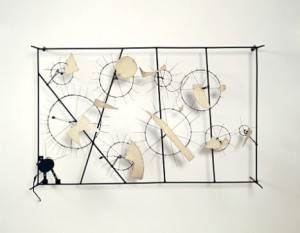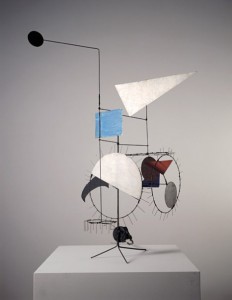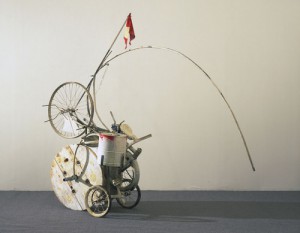Bio
Swiss sculptor Jean Tinguely was born in Fribourg on May 22nd, 1925. In 1939 Tinguely’s father found him an apprenticeship as a shop-window decorator in a department store. He then studied at the Kunstgewerbeschule, school of arts and crafts, in Basle from 1941 to 1945, and a period during which he discovered the art of Schwitters and Klee as well as becoming an enthusiastic fan of the Bauhaus, Dali, and Miro. During the war and the post-war period Tinguely joins Dr. Heinrich and his discussions with syndicates, anarchists, and ex-communists in a second-hand bookshop.
Tinguely began experimenting with movement in space in 1944 with his machine-like sculptures by equipping them with electric motors and making them spin around at high speeds. He moved to Paris in 1951, where he participated in Robert Rauschenberg’s international happenings and associated with the casual artist group “Nouveaux Réalistes”, exhibiting works in their exhibitions. The artist’s international fame came around the mid-1960s, if not earlier.
Tinguely married the artist Niki de Saint-Phalle, a close friend of his, in 1961. In 1962 Tinguely has his first solo show in Switzerland. Jean Tinguely died in Bern on August 30th, 1991 due to problems caused by a stroke.
Elément Détaché I, 1954
tubular steel frame, steel wire, 12 variously shaped cardboard elements, all painted white, 110V electric motor
Size: 81 x 131 x 35,5 cm
Tinguely affixed irregularly shaped pieces of Pavatex insulation, which he found in this form, onto the axes of the cogwheels and painted them white; these rotate with the motion of the relief.
Méta-Malevitch, 1954
black wooden box with seven rectangular, white-painted metal elements/ interior: wooden wheels, rubber belts, metal rods and electric motor
Size: 61 x 50 x 20 cm
These floating forms are mounted on fine wires that are connected behind the picture surface with wooden or metal wheels of different sizes. When the wheels are set in motion by drive belts connecting them with a likewise hidden motor, a continual series of new constellations appear on the picture surface.
Méta-mécanique, 1955
iron tripod, metal rods and wires, 9 variously coloured metal elements, electric motor
Size: 89 x 82 x 65 cm
The geometric elements painted in clear tones and set into motion in the wire sculptures recall Auguste Herbin’s abstract compositions and demonstrate Tinguely’s interest in making static art moveable and changeable.
Wundermaschine – Méta-Kandinsky I, 1956
wooden panel with 9 variously shaped and painted metal elements, wooden wheels, metal rods, rubber belts, 110V electric motor
Size: 39.8 x 103.2 x 33 cm
Multiple colors in this relief are accompanied by a great variety in shapes of compositional elements like “Méta-Maleviches”, the “Reliefs polychromes” also have various moving parts set before a background that is usually painted in a deep monochrome tone.
Fragment from Homage to New York, 1960
painted metal, fabric, tape, wood, and rubber tires
203.7 x 75.1 x 223.2 cm
Composed of bicycle wheels, motors, a piano, an addressograph, a go-cart, a bathtub, and other cast-off objects. Twenty-three feet long, twenty-seven feet high, and painted white, the machine was set in motion on March 18, 1960, before an audience in the MOMA’s sculpture garden.
Work Analysis
It is hard single out one of Jean Tinguely’s works as my personal favorite since all of them have inspired me in my own practice but Homage to New York, 1960, by the Swiss sculptor has to be at the top of the list. Not only was this piece a kinetic sculpture but it also played the role as a performative piece. Performed in the sculpture garden at the Museum of Modern Art in New York, a place where one day I would also like to show my work, this self-destroying mechanism performed for 27 minutes in front of invited guests. During it’s short running there were balloons inflated and popped, colored smoke came from these balloons. Paintings were made and destroyed, and bottles came crashing to the ground. An upright piano, metal drums, a radio broadcast, a recording of Tinguely explaining his work, and a competing shrill voice correcting him provided the chaotic sound to the machine’s self-destruction.
There are videos of the performance at the MOMA and it’s fascinating to see one of Tinguely’s works in motion these useless machines hold their own aesthetic and truly test what is and what isn’t art, beauty is in the eye of the beholder.
Frigo Duchamp, 1960
Artist’s Influences
Dadaism was the main artistic movement that influenced Jean Tinguely. Dadaism an anarchic art movement, looked to do away with the cultural and political ideas influenced by bourgeoisie society. Dadaist works were concerned with the understanding of beauty. Artists apart of Dadaism often challenged what was aesthetically pleasing to audiences by picking up irrational techniques and nonsensical styles. Performances were designed to confuse and stir-up audiences, making them question the aesthetic values they had inherited from society.
One can tell that this movement due to the choice of his materials influenced Tinguely. He often used discarded scrap or found objects to build his sculptures. These items would not usually be looked at as beautiful in a normal piece of art, and acted as another part of the Dadaist objective to challenge accepted aesthetic values. The use of such materials also acted as a commentary on the place of material objects and household items within society.
Tinguely’s choice of scrap materials for his sculptures, recycled metals, helps him in also destroying his own works. By using bicycle wheels, vehicle parts and industrial offal, his sculptures gave an untraditional beauty to objects that would have otherwise been disregarded for the purposes of art.






